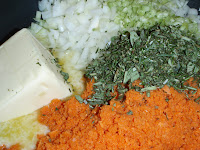There seems to be an underlying theme with my menus in the last couple of weeks. French. Perhaps, it is an unconscious protest in response to reading Bill Buford's, Heat in which Mario Batali's disdain for all things French is mentioned again and again.
I belong to a dinner club in which the host picks a theme and we all bring a dish to correspond with that theme. The latest gathering was an International Christmas dinner and I decided to make Tourtiere. Tourtiere is a traditional Quebecois Christmas dish and even though Quebec is still in Canada, much to the dismay of the Parti Quebecois, this dish feels somewhat foreign as it is not in my traditional Christmas line-up. If GWH has his way, though, it will be added from now on because he loved it although his opinion is probably skewed because I am pretty sure the fact that I decorated it with a Moose made him biased.
So Bon Apetit and Joyeux Noel to all!
...........See I am bilingual!
So Bon Apetit and Joyeux Noel to all!
...........See I am bilingual!
Ingredients
1-1/2 cups (375 mL) cubed peeled potato
1 lb (.5 kg) lean ground moose
1 lb (.5 kg) lean ground pork
2 cups (500 mL) mushrooms, finely chopped
3/4 cup (175 mL) celery, finely chopped
 3/4 cup (175 mL) chicken stock
3/4 cup (175 mL) chicken stock
2 onions, finely chopped
6 cloves garlic, minced
3/4 tsp (4 mL) salt
1/2 tsp (2 mL) pepper
1/2 tsp dry mustard
1/2 tsp (2 mL) each pepper, sage and thyme
1/4 tsp (1 mL) each ground cloves and cinnamon
 Pastry for double pie crust and cut outs
Pastry for double pie crust and cut outs
1 egg yolk
Directions
In saucepan of boiling salted water, cover and cook potato until tender, about 12 minutes. Drain and mash; set aside.
In a large bowl, mix together pork, moose, mushrooms, celery, stock, onions, garlic, salt, pepper, sage, thyme, cloves, cinnamon and potatoes. Set aside.
On lightly floured surface, roll out 1 of the pastry discs to scant 1/4-inch (5 mm) thickness. Fit into 9-inch (23 cm) pie plate. Spoon in filling. Roll out remaining pastry. Brush pie rim with water; cover with top pastry and press edge to seal. Trim and flute.
Roll out scraps; cut out desired shapes. (Make-ahead: Wrap tourtiere and shapes separately; refrigerate for up to 24 hours. Or overwrap in heavy-duty foil and freeze for up to 2 weeks; thaw in refrigerator. Add 20 to 30 minutes to baking time, covering with foil after 45 minutes; remove foil for last 10 minutes.)
Mix egg yolk with 2 tsp (10 mL) water; brush three-quarters over top. Arrange cutouts on top; brush with remaining egg wash. Cut steam vents in top.
Bake in bottom third of 400°F (200°C) oven until hot and golden brown, about 75 minutes.
NOTES:
If you find that the crust is browning too quickly, then cover loosely with tin foil for the remainder of cooking time.
I am submitting this to the Hearth n' Soul Blog hop.
1 lb (.5 kg) lean ground pork
2 cups (500 mL) mushrooms, finely chopped
3/4 cup (175 mL) celery, finely chopped
 3/4 cup (175 mL) chicken stock
3/4 cup (175 mL) chicken stock 2 onions, finely chopped
6 cloves garlic, minced
3/4 tsp (4 mL) salt
1/2 tsp (2 mL) pepper
1/2 tsp dry mustard
1/2 tsp (2 mL) each pepper, sage and thyme
1/4 tsp (1 mL) each ground cloves and cinnamon
 Pastry for double pie crust and cut outs
Pastry for double pie crust and cut outs1 egg yolk
Directions
In saucepan of boiling salted water, cover and cook potato until tender, about 12 minutes. Drain and mash; set aside.
In a large bowl, mix together pork, moose, mushrooms, celery, stock, onions, garlic, salt, pepper, sage, thyme, cloves, cinnamon and potatoes. Set aside.
On lightly floured surface, roll out 1 of the pastry discs to scant 1/4-inch (5 mm) thickness. Fit into 9-inch (23 cm) pie plate. Spoon in filling. Roll out remaining pastry. Brush pie rim with water; cover with top pastry and press edge to seal. Trim and flute.
Roll out scraps; cut out desired shapes. (Make-ahead: Wrap tourtiere and shapes separately; refrigerate for up to 24 hours. Or overwrap in heavy-duty foil and freeze for up to 2 weeks; thaw in refrigerator. Add 20 to 30 minutes to baking time, covering with foil after 45 minutes; remove foil for last 10 minutes.)
Mix egg yolk with 2 tsp (10 mL) water; brush three-quarters over top. Arrange cutouts on top; brush with remaining egg wash. Cut steam vents in top.
Bake in bottom third of 400°F (200°C) oven until hot and golden brown, about 75 minutes.
NOTES:
If you find that the crust is browning too quickly, then cover loosely with tin foil for the remainder of cooking time.
I am submitting this to the Hearth n' Soul Blog hop.






























